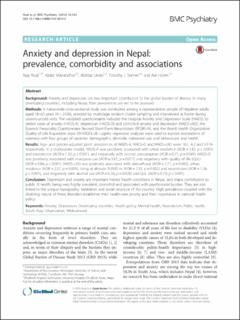| dc.contributor.author | Risal, Ajay | |
| dc.contributor.author | Manandhar, Kedar | |
| dc.contributor.author | Linde, Mattias | |
| dc.contributor.author | Steiner, Timothy J. | |
| dc.contributor.author | Holen, Are | |
| dc.date.accessioned | 2020-03-25T09:09:06Z | |
| dc.date.available | 2020-03-25T09:09:06Z | |
| dc.date.created | 2016-08-09T11:37:53Z | |
| dc.date.issued | 2016 | |
| dc.identifier.citation | BMC Psychiatry. 2016, 16:102 . | en_US |
| dc.identifier.issn | 1471-244X | |
| dc.identifier.uri | https://hdl.handle.net/11250/2648489 | |
| dc.description.abstract | Background
Anxiety and depression are two important contributors to the global burden of disease. In many developing countries, including Nepal, their prevalences are yet to be assessed.
Methods
A nationwide cross-sectional study was conducted among a representative sample of Nepalese adults aged 18–65 years (N = 2100), selected by multistage random cluster sampling and interviewed at home during unannounced visits. The validated questionnaires included the Hospital Anxiety and Depression Scale (HADS), to detect cases of anxiety (HADS-A), depression (HADS-D) and comorbid anxiety and depression (HADS-cAD), the Eysenck Personality Questionnaire Revised Short Form-Neuroticism (EPQRS-N), and the World Health Organization Quality of Life 8-question scale (WHOQOL-8). Logistic regression analyses were used to explore associations of caseness with four groups of variables: demographic, domicile, substance use, and behavioural and health.
Results
Age- and gender-adjusted point prevalences of HADS-A, HADS-D and HADS-cAD were 16.1, 4.2 and 5.9 % respectively. In a multivariate model, HADS-A was positively associated with urban residence (AOR = 1.82; p < 0.001) and neuroticism (AOR = 1.32; p < 0.001), and negatively with alcohol consumption (AOR = 0.71; p = 0.041). HADS-D was positively associated with marijuana use (AOR = 3.61; p = 0.017) and negatively with quality of life (QoL) (AOR = 0.86; p < 0.001). HADS-cAD was positively associated with widowhood (AOR = 2.71; p = 0.002), urban residence (AOR = 2.37; p = 0.001), living at altitude ≥2000 m (AOR = 2.32; p = 0.002) and neuroticism (AOR = 1.26; p < 0.001), and negatively with alcohol use (AOR = 0.56; p = 0.026) and QoL (AOR = 0.79; p < 0.001).
Conclusion
Depression and anxiety are important mental health conditions in Nepal, and major contributors to public ill health, being very highly prevalent, comorbid and associated with psychosocial burden. They are also linked to the unique topography, habitation and social structure of the country. High prevalence coupled with the disabling nature of these disorders establishes their health-care priority and their importance in national health policy. | en_US |
| dc.language.iso | eng | en_US |
| dc.rights | Navngivelse 4.0 Internasjonal | * |
| dc.rights.uri | http://creativecommons.org/licenses/by/4.0/deed.no | * |
| dc.title | Anxiety and depression in Nepal: Prevalence, comorbidity and associations | en_US |
| dc.type | Peer reviewed | en_US |
| dc.type | Journal article | en_US |
| dc.description.version | publishedVersion | en_US |
| dc.source.pagenumber | 9 | en_US |
| dc.source.volume | 16:102 | en_US |
| dc.source.journal | BMC Psychiatry | en_US |
| dc.identifier.doi | 10.1186/s12888-016-0810-0 | |
| dc.identifier.cristin | 1371407 | |
| dc.description.localcode | Open Access This article is distributed under the terms of the Creative Commons Attribution 4.0 International License (http://creativecommons.org/licenses/by/4.0/), which permits unrestricted use, distribution, and reproduction in any medium, provided you give appropriate credit to the original author(s) and the source, provide a link to the Creative Commons license, and indicate if changes were made. The Creative Commons Public Domain Dedication waiver (http://creativecommons.org/publicdomain/zero/1.0/) applies to the data made available in this article, unless otherwise stated. | en_US |
| cristin.ispublished | true | |
| cristin.fulltext | original | |
| cristin.qualitycode | 1 | |

